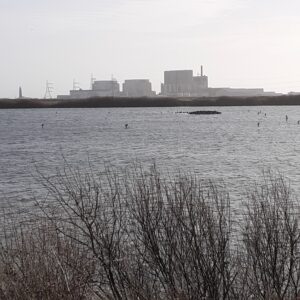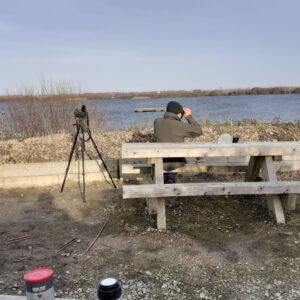Wednesday 24th January saw me, Debbie, Angela and Linda set out on our two hours plus trek to Dungeness. Was it worth battling along the A27? You bet it was! We set ourselves a challenging target of clocking up 40 species in the day but despite this pressure we chilled out with hot drinks and biscuits (well I had one) in the RSPB centre. Well, not totally chilled out as we immediately had some ducks to ID which was hampered a bit by looking into the sun. Nonetheless we spied out Shovelers and a few Teal. While paying for our drinks at reception we learned from the lady that Great Northern and Black Throated Divers had been seen regularly from the Centre and hides along the main stretch of water. Pulses quickening, we decided to visit the hide to the left of the Centre and, with the weather being so good, we were able to stand outside, next to it and scan the water. Amongst Herring Gulls and Cormorants were Tufted Ducks and some diving ducks showing a lot of white at the front. As we got better views, we could see the tell-tale white face patch of Goldeneye which was very exciting. All of a sudden Debbie called out “there’s one” and in the distance we saw a winter plumage Diver. Fantastic. Next problem was Great Northern or Black Throated. Since this question naturally rested on my shoulders I did what any experienced birder would do. I asked somebody else! He wasn’t too sure either but following further viewing and discussion we decided it was Black Throated mainly due to the shape of its head which did not appear to have the steep forehead of the other. I went over to the group and announced the verdict at which point my co-identifier came over and said he wasn’t so sure now!

In the hope that we would see it again later and perhaps closer we put final ID on hold and set off for our walk. Angela was soon hearing Cetti’s Warbler and Linda spotted our lone Oystercatcher of the day. The small pond where in past years a Long-Eared Owl has roosted held a group of Gadwall and at the first viewpoint we added Mallard and Wigeon. It was here that Debbie found the first Marsh Harrier of the day tantalizingly flying over the far-side vegetation constantly dipping out of view. As we continued a Chiffchaff flitted around the waterside vegetation and we picked up calls of Robin, Dunnock and Chaffinch.
At the next hide we were treated to the sculptural sight of Cormorants en masse decorating the branches of dead trees in the water. Even more were crammed onto an islet with a couple of Great Blacked Gulls which looked almost the same size in a different shape sort of way. Our one and only Pochard turned up on this stretch of water not to mention the huge raft of Coots. We discussed how this species is migratory in winter with some coming as far as from Russia. Who’d have thought that of a Coot?
We marched on to a short stop at the marshy area where there are often Snipe and sometimes other waders. No luck this time as any wading would have been under water. To compensate we were treated to a large “murmuration” of Lapwings in the distance. A last hide stop was taken where we have in the past seen Smew. Unlucky this time and, in fact, there were not a huge amount of birds present. We did add Great Crested Grebe and Heron which were the pick of the bunch until a couple of Marsh Harriers gave really good views. On leaving the hide we observed large groups of Grey Lag and Canada Geese amongst which we were pleased to find a small group of Barnacle Geese.
By now lunch was in our minds so we were a bit put out when the direct route back to the Centre was closed due to flooding. At the end of the long march we watched the birds on the feeders while getting food supplies from the car. Blue and Great Tits, Greenfinch, Goldfinch and House Sparrow. On to the picnic site by the first hide where we had seen the Diver. Withing moments Debbie had found a bird. This time it was pretty close and a nailed on Great Northern. We
soon spotted another bird which I am sure was the one we saw first and, although it was quite distant, it was clearly different and thankfully another birder confirmed it was a Black Throated. Wow and double Wow!
Just as everyone thought they could relax after lunch I herded them back to the car and we set off for a sea watch near the nuclear power station. Sounds wonderful doesn’t it. We drove past the Derek Jarman garden and parked near the old lighthouse before making the short trundle to the beach. Not too bitingly cold this trip! Immediately Debbie found two Gannets out amongst the numerous Gulls. Time prevented us really studying the Gulls although we were able to add Black Headed. I found some auks in the water which, after again discussing with a birder, were identified as Guillemot. I subsequently saw on the Dungeness Observatory website that the previous Friday over 3,000 Guillemots passed by and no mention of Razorbills which sort of confirmed our ID.
Before finally setting off for home we dropped into the local nature reserve opposite the RSPB Centre which was very atmospheric with the evening sun beginning to drop over the water. A roosting female Marsh Harrier was doing her toilette and a stunning male did a fly over as we traced our way back to the car.
We all thoroughly enjoyed what turned out to be our 11 hour day and we exceeded our target – 51 species.
Final species list:-
|
Mute Swan |
Black Throated Diver | Gt Black Backed Gull | Long Tailed Tit |
| Grey Lag Goose | Little Grebe | Herring Gull | Great Tit |
| Canada Goose | Great Crested Grebe | Guillemot | Blue Tit |
| Barnacle Goose | Gannet | Wood Pigeon | Jackdaw |
| Mallard | Cormorant | Feral Pigeon | Carrion Crow |
| Gadwall | Grey Heron | Meadow Pipit | Magpie |
| Shoveler | Marsh Harrier | Pied Wagtail | Starling |
| Wigeon | Coot | Dunnock | House Sparrow |
| Teal | Moorhen | Robin | Chaffinch |
| Pochard | Oystercatcher | Blackbird | Greenfinch |
| Tufted Duck | Lapwing | Chiffchaff | Goldfinch |
| Goldeneye | Curlew | Cetti’s Warbler | Reed Bunting |
| Great Northern Diver | Black Headed Gull | Wren |